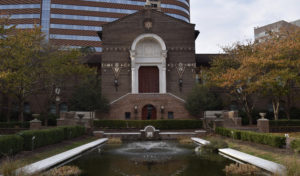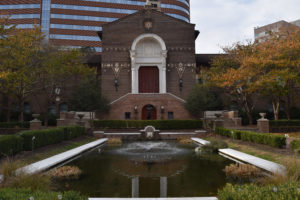
In January 2021, the Penn Museum will reopen its doors once again, welcoming visitors with their new upcoming exhibit, Invisible Beauty: The Art of Archaeological Science. With this, visitors will get an exclusive behind-the-scenes look at the science of archaeology in the lab, and the beauty hidden within ordinary objects of our past. “One of the reasons for this exhibit is to highlight what we do in the laboratory, what archaeologists and anthropologists do in the laboratory when they’re not excavating,” explains Dr. Marie-Claude Boileau, the Director of the Center for the Analysis of Archaeological Materials (CAAM) at the Penn Museum, University of Pennsylvania. “When we do have a few visitors that come and see us in the lab, they look down a microscope and they’re really blown away by what objects look like at higher magnification. There’s a beauty to these images and there’s also a lot of information, particularly showing how a very tiny sample is really packed with information about the past.”
CAAM was founded in 2014 by the Penn Museum and the School of Arts and Sciences at the University of Pennsylvania. Dr. Boileau, explains, “This was part of the big push for the museum to bring in students into the museum to do research and take formal classes, which really complements the museum’s Academic Engagement department.” Students of CAAM have the unique opportunity to study archeological science, an interdisciplinary field bridging the gap between the hard sciences and the humanities by researching and studying objects and specimens from the museum. “That’s actually how we captured some of these images,” says Dr. Boileau. Invisible Beauty showcases the various areas of studies students can explore during their academic careers in CAAM, from archaeobotanical remains to landscapes and more.
According to Dr. Sarah Linn, a University of Pennsylvania Alumna herself, “It is exciting that there are students who have now taken CAAM courses throughout their entire career at Penn. Undergraduates begin in these introductory courses and they ultimately come out as amazing archaeobotanists or zooarchaeologists. There is also an enormous amount of support for students doing Ph.D.’s and other intensive research projects. When I started my Ph.D. at Penn in 2009 we had nothing like this. These students have the incredible opportunity to do their coursework and then pursue their dissertations with remarkable support from archaeometallurgists and ceramics specialists. It is a great program that dovetails really nicely with the work we do in Academic Engagement, allowing us to support students in a robust way. This exhibit provides an additional opportunity for students to gain experience showcasing their work to the public.”
Invisible Beauty shows various objects from research being conducted by the Penn Museum and CAAM, imaged to reveal hidden informatio. Dr. Linn, a Mediterranean archaeologist who works closely with graduate students, was discussing a microscopic image with student Olivia Hayden [who has since completed her Ph.D.] when the idea for Invisible Beauty was born. “While talking to [Dr. Hayden] about her research and some of the images she’d been capturing throughout her research in CAAM, I was just struck by an incredibly beautiful image of a bronze needle from Cyprus. It has a great story behind it as well, but it is also just visually appealing. I reached out to Dr. Boileau, who was also excited about showing some of these images to the public, and we realized that we could do an exhibit that captures the visual appeal, but that also leads to some great stories and highlights the work we are doing in the labs, and out in the field as well.”
The exhibit showcases a range of images from around the world, spanning dates from approximately 40,000 BCE to 1967 CE. In addition to the bronze needle that started it all, visitors will also enjoy magnified images of a microscopic diatom, ceramic materials, obsidian used by students in experimental archaeology trials, textiles, and more. “One image shows a copper alloy dagger that was wrapped in a textile when it was buried, but over time the corrosion took over the textile itself, and it actually took the shape of the fibers,” Dr. Boileau explains. “We call these pseudomorphs, and so we actually have the view of what the textile weaving pattern would have looked like [had it been preserved in its original form].” All images are displayed alongside information about the instruments and magnification used to capture the images.
Some images are displayed alongside the actual object that was studied in the lab, as well. “Some of them are almost complete,” Dr. Boileau explains. “So visitors can appreciate those, but we’re also showing objects and specimens you normally would not see in an exhibit; these are fragmentary, like broken pieces of pottery, maybe very small, and they might look like there’s nothing exciting about them, but then you put them under the microscope and it comes to life.”
Not only is Invisible Beauty an aesthetically pleasing exhibit to explore, but it also showcases the kind of information archaeologists can obtain by conducting these scientific studies on everyday objects. “Scale is a big part of this,” says Dr. Linn. “We have images ranging from the microscopic diatom, which is magnified more than twenty-thousand times, all the way to large-scale landscapes in Turkey.” The magnification of these objects and specimens can also reveal important information about the crafting of everyday objects, as was the case with Dr. Hayden’s bronze needle. “The image is a striking gold-colored swirl,” Dr. Linn explains. “The object itself is not much to look at—it is a corroded bronze needle, so it really doesn’t look like much. But when you get to the actual metal and take a tiny sample of it, it’s beautiful and you can learn so much about it.” Dr. Hayden conducted a great deal of research on two needles discovered together in a tomb at a site called Lapithos on Cyprus, consisting of various forms of analysis, including elemental analysis and microscopy. She suggests the needles were actually made by the same craftsperson. Her goal was to determine how the craft is transmitted, not just the material. “As archaeologists we focus so much on trade and how people are learning to do these crafts, so to have two objects made by the same person is incredible,” she says. “You can see the swirl marks on this image that show how the craftsperson was actually turning the needle as they were hammering it.”
Dr. Boileau and Dr. Linn hope that visitors will come away from this behind-the-scenes look at the lab work done by researchers at the Penn Museum with a better understanding of the kinds of work archaeologists do when they’re not in the field, and with a sense of wonder. They want to ignite a curiosity in their viewers about objects and the information that can be unlocked when looking at things at these scales.
Invisible Beauty can be enjoyed by visitors at the Penn Museum from January 2021 to June 2021.
______________________________
About the Penn Museum
 The Penn Museum (the University of Pennsylvania Museum of Archaeology and Anthropology) is dedicated to the study and understanding of human history and diversity. Founded in 1887, the Museum has sent more than 300 archaeological and anthropological expeditions to all the inhabited continents of the world. With an active exhibition schedule and educational programming for children and adults, the Museum offers the public an opportunity to share in the ongoing discovery of humankind’s collective heritage.
The Penn Museum (the University of Pennsylvania Museum of Archaeology and Anthropology) is dedicated to the study and understanding of human history and diversity. Founded in 1887, the Museum has sent more than 300 archaeological and anthropological expeditions to all the inhabited continents of the world. With an active exhibition schedule and educational programming for children and adults, the Museum offers the public an opportunity to share in the ongoing discovery of humankind’s collective heritage.
The museum is located at 3260 South Street, Philadelphia, PA 19104 (on Penn’s campus, across from Franklin Field). Public transportation to the Museum is available via SEPTA’s Regional Rail Line at University City Station; the Market-Frankford Subway Line at 34th Street Station; trolley routes 11, 13, 34, and 36; and bus routes 21, 30, 40, and 42. Museum hours are Tuesday through Sunday, 10:00 am to 5:00 pm. Museum admission donation is $18 for adults; $16 for senior citizens (65 and above); $13 for children ages 6-17. Admission to the Penn Museum is FREE for U.S. military, reservist personnel, and veterans, teachers, and children ages 5 and under.
_______________________________





